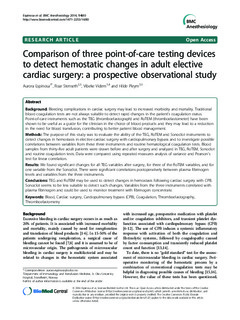| dc.contributor.author | Espinosa, Aurora | |
| dc.contributor.author | Stenseth, Roar | |
| dc.contributor.author | Videm, Vibeke | |
| dc.contributor.author | Pleym, Hilde | |
| dc.date.accessioned | 2015-09-30T07:50:58Z | |
| dc.date.accessioned | 2015-11-18T14:47:09Z | |
| dc.date.available | 2015-09-30T07:50:58Z | |
| dc.date.available | 2015-11-18T14:47:09Z | |
| dc.date.issued | 2014 | |
| dc.identifier.citation | BMC Anesthesiology 2014, 14(1) | nb_NO |
| dc.identifier.issn | 1471-2253 | |
| dc.identifier.uri | http://hdl.handle.net/11250/2364627 | |
| dc.description.abstract | Background:
Bleeding complications in cardiac surgery may lead to increased morbidity and mortality. Traditional blood coagulation tests are not always suitable to detect rapid changes in the patient's coagulation status. Point-of-care instruments such as the TEG (thromboelastograph) and RoTEM (thromboelastometer) have been shown to be useful as a guide for the clinician in the choice of blood products and they may lead to a reduction in the need for blood transfusion, contributing to better patient blood management.
Methods:
The purpose of this study was to evaluate the ability of the TEG, RoTEM and Sonoclot instruments to detect changes in hemostasis in elective cardiac surgery with cardiopulmonary bypass and to investigate possible correlations between variables from these three instruments and routine hematological coagulation tests. Blood samples from thirty-five adult patients were drawn before and after surgery and analyzed in TEG, RoTEM, Sonoclot and routine coagulation tests. Data were compared using repeated measures analysis of variance and Pearson's test for linear correlation.
Results:
We found significant changes for all TEG variables after surgery, for three of the RoTEM variables, and for one variable from the Sonoclot. There were significant correlations postoperatively between plasma fibrinogen levels and variables from the three instruments.
Conclusions:
TEG and RoTEM may be used to detect changes in hemostasis following cardiac surgery with CPB. Sonoclot seems to be less suitable to detect such changes. Variables from the three instruments correlated with plasma fibrinogen and could be used to monitor treatment with fibrinogen concentrate. | nb_NO |
| dc.language.iso | eng | nb_NO |
| dc.publisher | BioMed Central | nb_NO |
| dc.title | Comparison of three point-of-care testing devices to detect hemostatic changes in adult elective cardiac surgery: A prospective observational study | nb_NO |
| dc.type | Journal article | nb_NO |
| dc.type | Peer reviewed | en_GB |
| dc.date.updated | 2015-09-30T07:50:57Z | |
| dc.source.volume | 14 | nb_NO |
| dc.source.journal | BMC Anesthesiology | nb_NO |
| dc.source.issue | 1 | nb_NO |
| dc.identifier.doi | 10.1186/1471-2253-14-80 | |
| dc.identifier.cristin | 1180714 | |
| dc.description.localcode | © 2014 Espinosa et al.; licensee BioMed Central Ltd. This is an Open Access article distributed under the terms of the Creative Commons Attribution License (http://creativecommons.org/licenses/by/4.0), which permits unrestricted use, distribution, and reproduction in any medium, provided the original work is properly credited. The Creative Commons Public Domain Dedication waiver (http://creativecommons.org/publicdomain/zero/1.0/) applies to the data made available in this article, unless otherwise stated. | nb_NO |
